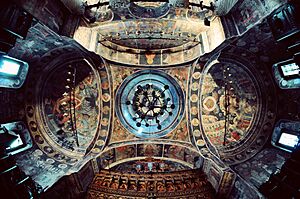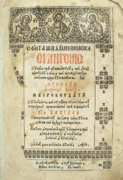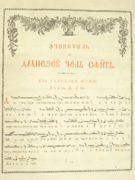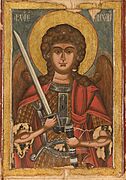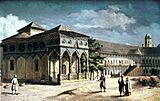Stavropoleos Monastery facts for kids
Quick facts for kids Stavropoleos Monastery |
|
|---|---|
|
Mănăstirea Stavropoleos
|
|
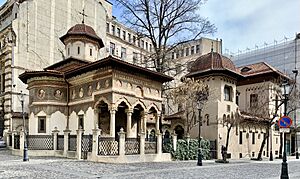
The monastery in April 2021
|
|
| Religion | |
| Affiliation | Eastern Orthodox |
| Patron | Holy Archangels Michael and Gabriel |
| Year consecrated | 2008 |
| Status | Active |
| Location | |
| Location | 4 Stavropoleos Street, Sector 3, Bucharest |
| Architecture | |
| Architectural style | Brâncovenesc |
| Founder | Archimandrite Ioanichie Stratonikeas |
| Completed | 30 October 1724 |
| Materials | Stone |
The Stavropoleos Monastery is an Eastern Orthodox monastery for nuns located in the center of Bucharest, the capital of Romania. For about 100 years, the monastery was closed, and it was known only as Stavropoleos Church.
Its beautiful church is built in the special Brâncovenesc style, a unique Romanian architectural style. The church is dedicated to the St. Archangels Michael and Gabriel. The name Stavropoleos comes from the Greek word Stavropolis, which means "The city of the Cross."
The monastery is famous for its focus on Byzantine music. It has a special choir and the largest collection of Byzantine music books in all of Romania.
Contents
The Story of the Monastery
The church was first built in 1724. This was during the time when Nicholas Mavrocordatos was the Prince of Wallachia, a region in Romania. The founder was a Greek monk named Ioannikios Stratonikeas.
Ioannikios owned an inn, and he built the church and a monastery right next to it. The money earned from the inn helped support the monastery, which was a common practice back then.
In 1726, Ioannikios became a bishop of a place called Stavropolis. From then on, the monastery he built was called Stavropoleos. Ioannikios died in 1742 and was buried in his church.
Changes Over the Years
Sadly, the inn and other monastery buildings were torn down in the late 1800s. The church also suffered damage from earthquakes, which caused its dome to fall. The paintings on the dome were carefully restored in the early 20th century.
Today, only the church from the original monastery is still standing. Next to it is a newer building from the early 1900s. This building holds a library, a meeting room, and a collection of old religious art. It has icons and wall paintings that were saved from other churches torn down during Romania's communist era.
Since 1991, a community of nuns has lived at the monastery. They hold regular worship services and also work to repair old books, icons, and church clothing.
A Library Full of Treasures
The monastery's library is home to more than 8,000 books. These books cover topics like religion, Byzantine music, art, and history. Many of the books were donated from the personal library of Vasile Drăguț, a famous art historian.
The library has a large number of very old books. This includes over 80 handwritten books, called manuscripts, and 400 old printed books. These books are written in Romanian, Greek, and Church Slavonic.
The collection of Byzantine music books is the largest in Romania. The monastery is also working on a project to scan its old books and create a "virtual library" online.
The Sound of Byzantine Music
The music sung during church services is a modern style of Byzantine music. This music is based on the works of Romanian composers from the 1800s.
The Stavropoleos Byzantine Choir was formed in 1994. The choir performs a special kind of music where one main voice sings the melody, supported by a long, continuous note in the background. This style of singing is not very common in Romanian churches today. The choir has performed in Romania and in other countries and has recorded its music on CDs.
Gallery
See also
 In Spanish: Monasterio Stavropoleos para niños
In Spanish: Monasterio Stavropoleos para niños
- Depiction of a typical Orthodox Church building
- List of monasteries in Bucharest
- Romanian Orthodox Church


